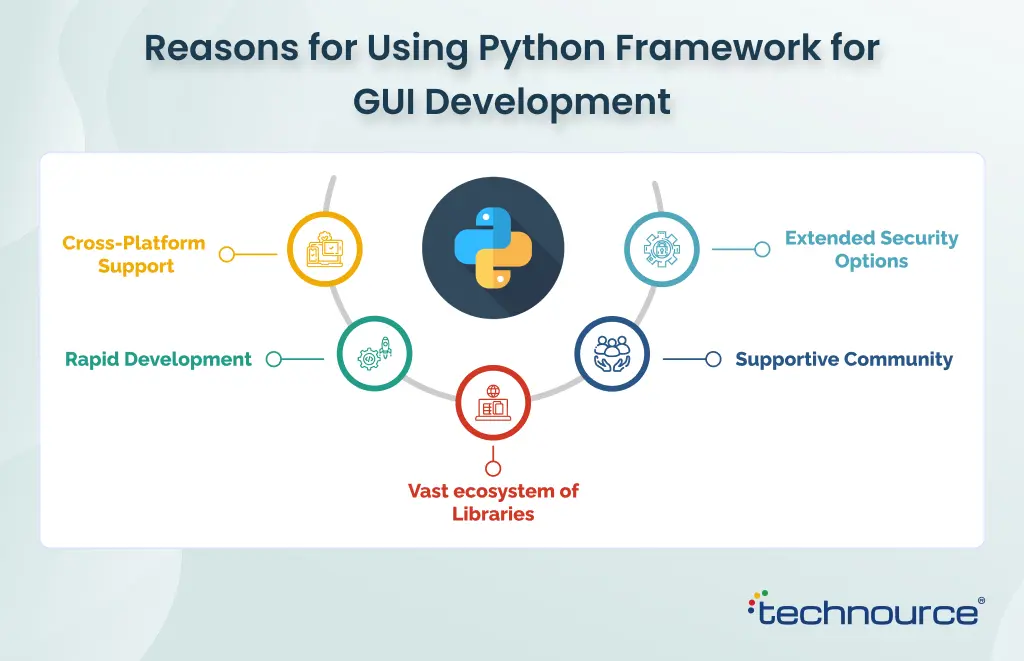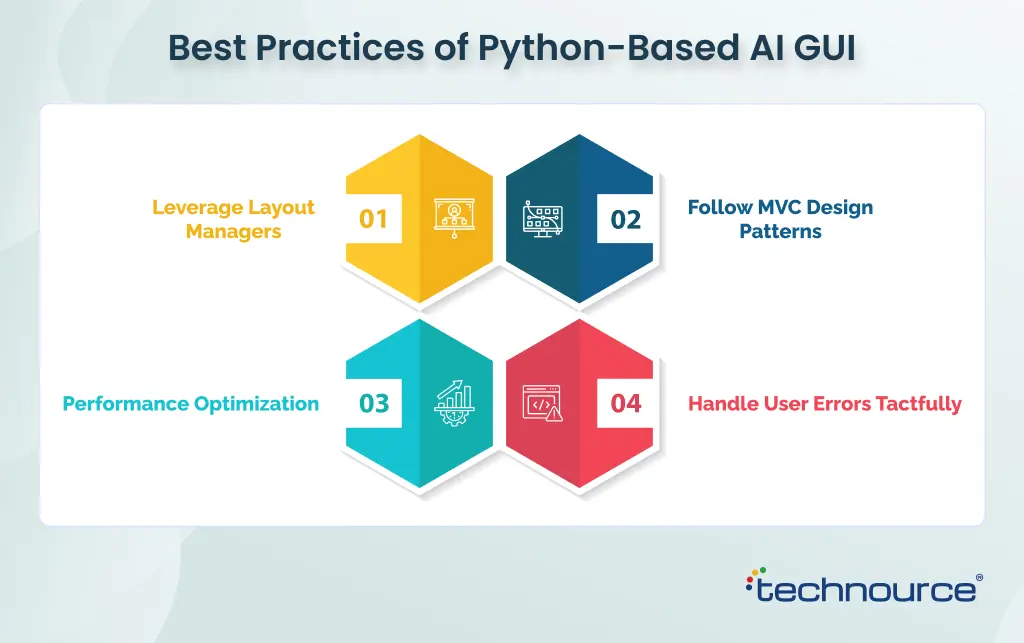Best Python GUI Frameworks to Build AI Applications in 2025
Quick Summary: The versatility of Python and its frameworks is offering developers more options to build user-friendly AI applications. The revolution of rich GUI frameworks is simplifying the AI app development process. In this blog, we’re going to uncloak the top Python frameworks to help you develop scalable, robust, and responsive applications.
A few years ago, when I was approached by clients asking, “Can you develop the user interface of an AI using Python frameworks?” my brain literally started rebelling!
Typical bottlenecks, such as uncentered buttons, window scaling issues, and outdated layout managers, constantly ruined my good night’s sleep, even after a toiling day.
Finally, one of my teammates introduced me to the Python GUI frameworks, and it felt like walking in the park! No fluff, real code and the best part is that you can use these frameworks for real-world projects!
According to Statista, 51% of developers worldwide are utilizing Python GUI libraries to meet the evolving needs of development.
If you want to make your entrepreneurial journey easier (and your sleep too!) with Python GUI libraries that offer multiple advantages, this blog will show you the real options. With this guide, you can make the right decision for developing the next AI application for your client.
What Are Python GUI Frameworks?
Let’s get it straight: a Python GUI is a simple graphical user interface that interacts with elements, including dropdown menus, sliders, checkboxes, etc. Python GUI frameworks enable programmers to design the interface of an AI-based application by offering pre-built components and tools, which speeds up the development process.
What are Python GUI Libraries?
What makes Python a preferred language for GUI development? The answer is- Python GUI libraries. During a SaaS application development for one of our clients, Python GUI libraries have simplified the creation of a user-friendly application by providing the necessary components.
The Python GUI library includes elements such as menus, icons, windows, and buttons. These enable the developers to design enticing and intuitive interfaces. Options range from platform-specific tools to cross-platform frameworks, allowing you to choose a suitable library based on your specific requirements.
Reasons Why Experts Are Using Python Framework for GUI Development?
Did you know that selecting Python GUI frameworks for AI application development can impact the speed, user experience, and overall application performance? Yes, that’s right! In fact, we didn’t initially share the same idea, but once we chose the Python GUI framework for AI projects, we came to believe the same. We implemented the same AI projects as follows.
Recently, Stephen has approached us to develop a healthcare SaaS application for his brand. Since he had a budget constraint, he wasn’t convinced about building AI applications with a Python GUI. However, once I explained to him the benefits of Python GUI for AI applications, he was convinced. Here’s what we had discussed-
Client: Hey, I checked that your team has experience in developing AI applications for healthcare needs. Can they assist me in developing an application for my brand?
Me: Of course! We can take your brand to the next level with our skilled, streamlined, and comprehensivev AI app development services. Generally, we use Python GUI modules to develop responsive AI applications.
Client: Oh, that’s expensive! We’re a mid-sized company, and that cost will impact our resources.
Me: I respect your opinion, but choosing a cheaper option might be the wrong decision! In a worst-case scenario, things may collapse over time, and you have to pay us again to fix the entire application!
Client: Hmm, that’s a valid point, but could you please brief me on what benefits I will get if I use a Python framework for my AI application?
Me: From cross-platform compatibility to extensive library support, you will get a full platter that will enrich your application.
Client: Alright, let’s go with Python Framework then!
It’s not only us! A survey by JetBrains claims that 38% of Python developers use GUI frameworks for AI application development because of their advantages. Here you go-
- Cross-Platform Support – Python GUI framework has cross-platform compatibility. This enables applications to run seamlessly across multiple operating systems.
- Rapid Development – The readability and simplicity of Python enable developers to write code efficiently, reducing precious effort and time.
- Vast ecosystem of Libraries – The vast ecosystem of Python modules and libraries provides an easy facility to integrate GUI applications with AI applications.
- Supportive Community – The vibrant and supportive community of Python contributes towards its growth by providing a wealth of resources, forums, and tutorials for enhanced learning.
- Extended Security Options – Enriched with security options, Python frameworks have features including code scanning, sorting external data, etc., to build a security layer.
Top 5 Powerful Python GUI Frameworks for 2025 and Beyond
“Python has been an important part of Google since the beginning, and remains so as the system grows and evolves. Today, dozens of Google engineers use Python, and we’re looking for more people with skills in this language,” said Peter Norvig, director of search quality at Google, indicating the efficacy of Python. To date, Python is one of the top choices for developing AI web and mobile applications due to its readability, versatility, and vast ecosystem.
The powerful frameworks of Python simplify the process, handling requests from routing to database management. In the following paragraph, we will discuss the best Python GUI framework for developing AI applications. Here you go-
1. Tkinter
Created by Fredrik Lundh, Tkinter is one of the reliable and efficient toolkits. It has a standard interface that makes it an excellent choice for developers to new GUI development. The preinstallation feature with Python reduces the need for additional setup. Therefore, the users can develop GUIs instantly. This is the best fit if you want to build AI applications with Python GUI.
Key features
- Tkinter needs no additional setup as it comes preinstalled with Python.
- Apply any themes easily to improve GUI aesthetics.
- Beginners can pick up quickly due to fewer complications.
- Compatible with Linux, Windows, and Mac platforms.
- Wide range of resources is available for learning and troubleshooting.
Advantages
- The flexibility for basic GUI development makes it #1 when it comes to developing AI applications.
- For small projects, the stability and reliability enable the developer to keep up with the project requirements.
- As the framework is preinstalled, it doesn’t require any installation.
Disadvantages
- The support for advanced widgets and customization is limited.
- Best fit for simplistic GUI applications.
- The GUIs have an outdated look compared to other Python web development frameworks.
- Tkinter is lightweight and performs well for small apps; its GUI appearance may look outdated compared to modern frameworks.
Should You Opt for Tkinter?
If you’re looking for a quick and open-source Python UI for AI applications, Tkinter is ready to serve! However, these features are best suited if stability and simplicity are your top priorities. For advanced needs, you may choose an alternative framework.
2. PyQt6
This is the latest package for the PyQt series, offering robust bindings. If your team is developing a cross-platform application, this framework is an appropriate choice, as it helps developers create robust applications for Linux, Android, Windows, and iOS.
Key Features
- Offers seamless integration with SQL databases.
- Provides comprehensive support for the latest Qt 6.x.
- Extensive Python GUI libraries.
- A rich tapestry of native widgets to develop intuitive interfaces.
- Offers a cross-platform development option.
- Extensive community support is available.
Advantages
- Supports the development of both simple and complex applications.
- A suite of visual elements and native widgets is available for the developers.
- A pool of active developers is available in the community to help fellow developers.
Disadvantages
- Needs to be installed via the Python package index.
- Limited documentation scopes.
- A bit heavier setup compared to other frameworks.
Should You Opt for PyQt6?
Features like cross-platform solutions, multiple operating system support and intuitive interfaces make this an ideal choice for developers. If you want to create premium Python graphical interfaces, this would be an ideal option.
3. Kivy
A modern-looking interface of a modern SaaS application is welcomed mainly by users due to its vividness and ease of use. Kivy, an OpenGL ES 2-accelerated framework, is designed to meet the needs of modern SaaS applications. This supports iOS, Android, Windows, and Linux operating systems. With over 20 widgets in the toolkit, Kivy is a good option for creating intuitive user interfaces.
Key Features
- Supports various gestures and touch input to make it suitable for developing touch-screen-based applications.
- Developed using OpenGL, which offers quick graphics rendering and allows developers to develop visually aesthetic apps with smoother animation.
- Based on MVC architecture and uses a specific language to define the user interface.
Advantages
- Enables developers to develop robust AI applications that run on multiple platforms, including iOS, macOS, Windows, Android, and Linux.
- Designed for mobile phones, tablets, and other touch-based devices to develop natural and intuitive user interfaces.
- Developed using Open GL, which provides quick graphics rendering and allows the developers to curate visually aesthetic applications.
Disadvantages
- Compared to other Python frameworks, it has a smaller number of third-party libraries. This makes it difficult for the developers to find specific tools.
- Most often, Kivy has performance issues while running complex apps, especially on outdated devices.
- If you’re searching on Google “how to build an AI software”, chances are higher that you will get the search results with various community pages. Likewise, Kivy has community support, although not to the same extent as other Python frameworks.
Should You Opt for Kivy?
If you’re looking for a versatile yet powerful framework to build cross-platform applications, Kivi is the better option. Develop multi-touch applications with Kivy and run on multiple platforms.
4. PySimpleGUI
This framework is as straightforward as water, allowing beginners to develop applications quickly. However, remember that PySimpleGUI wraps Tkinter, Qt, or Remi for rapid development, making it beginner-friendly. It is a wrapper library rather than a full GUI engine.. This factor makes the job easier for developers, as they gain immediate access to all the elements.
Key Features
- Provides options to beginners who are looking to learn a Python GUI framework for AI projects.
- Runs fine on multiple OS, including Windows, macOS and Linux platforms.
- For experienced developers, native functionalities are available.
Advantages
- Open-source platform.
- Provides the option to develop cross-platform applications.
- The learning curve is shallow.
- Plenty of resources are available.
Disadvantages
- Only supports Python 3.
- Needs to be installed via pip.
Should You Opt for PySimpleGUI?
If your development team includes newbies, consider using PySimpleGUI, as it offers multiple elements for developing intuitive user interfaces. Also, full native functionality is available for experienced developers.
5. wxPython
Create native-looking UIs without adding many components using the wxPython GUI library. This framework includes many widgets that support all platforms.
Key Features
- Irrespective of the platform, GUIs look like premium native applications.
- This framework is flexible.
- A large number of experts are available in the community so that you can exchange news and ideas regarding GUI development.
Advantages
- Cross-platform framework
- Like other frameworks, this is an open-source framework.
- Development is active
Disadvantages
- Updates may occasionally introduce issues, but the framework is stable. Moving forward, it affects the final output quality.
- Without pip, you can’t install this framework.
Comparison Table: Top 5 Python GUI Framework Features
| Feature | Tkinter | PyQt6 | Kivy | PySimpleGUI | wxPython |
|---|---|---|---|---|---|
| Flexibility | Flexible and stable. | Flexible coding scopes that cater to both small and large-scale apps. | Easy to use and understand. | Simple and easy to use. An excellent choice for beginners. | Serves according to different coding demands. |
| Python Inclusion | Pre-installed. | Not pre-installed. | Not pre-installed. | Not pre-installed. | Not pre-installed. |
| Performance | Best for light applications. | Provides all-around performance, regardless of app size. | Provides excellent performance due to GPU acceleration. | Mild to moderate performance. | Provides medium performance. |
| License | Open | Licensing: GPL or commercial license. | Open | Two-tier licenses are available i.e., commercial license and hobbyist license. | Open |
Things to Consider When Choosing a Python Graphical User Interface
If you’re building an AI software through a Python GUI framework, don’t forget to consider a few factors. This includes the application complexity, framework familiarity, and other specific project requirements. Here are the guidelines that you must follow during choosing the best Python framework for your next project-
- Complexity – Python GUI frameworks vary in complexity. From low-code platforms to advanced frameworks, developers can choose the one that suits them best based on their knowledge.
- Ease of Use – This option directly affects how quickly your team can start developing and iterating. Check for clear documentation, extensive community support and intuitive interfaces that simplify the development process. Therefore, it will reduce onboarding time and minimize the chances of errors.
- Performance – According to the latest AI development statistics, AI will handle more data, users and complex tasks. Therefore, choosing a proven framework for performance will enable it to load and scale easily. As a result, it will foster the application performance.
- Seamless Integration – Your chosen framework needs to be integrated with existing tools and systems to ensure optimal performance.
Best Practices for Building Python-Based AI GUIs
Irrespective of the Python GUI framework you choose, follow the best practices to ensure a smooth Python app development process:
- Leverage Layout Managers – Use the power of layout managers provided by GUI frameworks to reposition your widgets easily. This will ensure the graphic user interface looks consistent across various device sizes.
- Follow MVC Design Patterns – Segregate the application logic from GUI code by following MVVM or MVC design patterns. Therefore, it will make your code reusable, modular and easier to maintain.
- Performance Optimization – Use caching techniques and lazy loading to optimize the performance of the GUI application. Avoid unnecessary complications during development to ensure that your application responds quickly.
- Handle User Errors Tactfully – Utilize the power of proper error handling and validation to manage the user input effectively.
How Technource Built a Scalable SaaS Platform Using PyQt
Challenge: The company required a high-performance SaaS application to streamline their staffing business, followed by replacing the existing application. The new system requires real-time data collection, integration with other applications and cross-platform deployment.
Why Our Team Selected PyQt: Due to its advanced features, we have chosen PyQt to keep the UI responsive during rigorous application usage. The cross-platform support and the professional experience were the main key benefits.
Final Outcome: With the pool of native widgets and enriched visual elements, our team has developed a visually aesthetic GUI that provides optimal performance during peak times. Additionally, the client feedback was positive, stating that the overall performance has improved by 62%.
Winding Up
Choosing the right Python GUI framework for AI projects is a crucial step in developing user-friendly applications. Each framework offers unique value based on the requirements. Understanding the best practices and top frameworks in GUI development will enable you to make informed decisions about your approach.
If you’re still on the fence and looking for a solution, our team is ready to alleviate your anxiety. As a reputable web development company, we cater to our clients with the best and trending services that bring value. Take a notepad and jot down your issues today so that our team can help you resolve them through a robust development process. Will that work?
A Python GUI framework is a collection of modules that facilitates the creation of GUIs for Python-written applications. These frameworks have pre-built components, including menus, text boxes, and windows, so that they can be easily assembled. The best Python framework depends on the specific needs for a project, including the target platform, interface complexity, and customization level. Yes, Tkinter is suitable for developing the GUI component of AI applications, especially when a lightweight interface is needed. PySide, TKinter, Kivy, and wxPython are some of the best frameworks for developing desktop applications because they are open source, easy to learn, and provide cross-platform compatibility.
Request Free Consultation
Amplify your business and take advantage of our expertise & experience to shape the future of your business.










